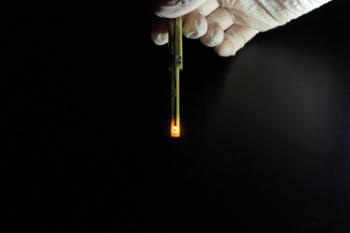
An OLED of the type used in the experiment, which glows orange under an electrical current. (Image: Andy Brimhall, University of Utah Marketing and Communications)
The domain of “spintronics”—the ability to achieve electronic effects by manipulating subatomic quantum spin—has long tantalized researchers with its possibilities in quantum information processing, superefficient data storage, low-power displays, and more. Now, scientists in the United States, Australia, and Germany report an important step toward practical spintronics: they have used the resonant quantum spins of hydrogen nuclei to control an electric current powering an organic LED (OLED), at room temperature (Science, doi: 10.1126/science.1255624).
The experiments ultimately involve reading the orientation of what one of the lead researchers, Christoph Boehme of the University of Utah, USA, called “the tiniest magnets in nature,” the spins of atomic nuclei. Four years ago, Boehme and coworkers achieved the ability to read out and control nuclear spins on a silicon platform and use them to store electronic information—but only at temperatures a few degrees above absolute zero.
The new work displays a similar feat at room temperature, using MEH-PPV OLEDs, spiked with either hydrogen or deuterium, as the structures to explore pulsed magnetic resonances. The team fabricated an OLED pixel onto a radio frequency (RF)-compatible substrate, and tied it to thin-film contact leads made of indium tin oxide and aluminum. The scientists then bombarded the OLED sample with microwave and RF energy to flip the spins of the nuclei in the sample, and were able to read the “echo” of those manipulations in current flowing through the OLED.
The modulation frequency of the current echo corresponded to the nuclear spin precession frequency, which changed depending on whether the sample contained embedded hydrogen or deuterium—a confirmation of the coupling between the nuclear spin and the electronic signal. And the switching is extremely efficient: the team notes that this room-temperature control occurs on energy scales on the order of 100 neV, six orders of magnitude below the thermal energy.
The road from this step to true, superefficient spintronic devices for computer memory and data processing is apt still to be a long one; researchers have much to figure out in how to wire up complex, practical platforms spintronically. But Boehme says that the demonstration of this control, in a practical, plastic semiconductor platform, marks an important proof of principle, showing that “we can control a current by controlling nuclear spin.”
